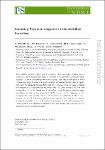Summing Feynman diagrams in the worldline formalism
| dc.contributor.author | Edwards, J | |
| dc.contributor.author | Ahmadiniaz, N | |
| dc.contributor.author | Lopez-Arcos, C | |
| dc.contributor.author | Lopez-Lopez, MA | |
| dc.contributor.author | Moctezuma Mata, C | |
| dc.contributor.author | Nicasio, J | |
| dc.contributor.author | Schubert, C | |
| dc.date.accessioned | 2023-12-16T15:21:29Z | |
| dc.date.available | 2023-12-16T15:21:29Z | |
| dc.date.issued | 2022-10-20 | |
| dc.identifier.uri | https://pearl.plymouth.ac.uk/handle/10026.1/21797 | |
| dc.description.abstract |
The worldline formalism shares with string theory the property that it allows one to write down master integrals that effectively combine the contributions of many Feynman diagrams. While at the one-loop level these diagrams differ only by the position of the external legs along a fixed line or loop, at multiloop they generally involve different topologies. Here we summarize various efforts that have been made over the years to exploit this property in a computationally meaningful way. As a first example, we show how to generalize the Landau-Khalatnikov-Fradkin formula for the non-perturbative gauge transformation of the fermion propagator in QED to the general 2n - point case by pure manipulations at the path-integral level. At the parameter-integral level, we show how to integrate out individual photons in the low-energy expansion, and then sketch a recently introduced general framework for the analytical evaluation of such worldline integrals involving a reduction to quantum mechanics on the circle and the relation between inverse derivatives and Bernoulli polynomials. | |
| dc.title | Summing Feynman diagrams in the worldline formalism | |
| dc.type | conference | |
| plymouth.date-start | 2022-04-25 | |
| plymouth.date-finish | 2022-04-30 | |
| plymouth.volume | 416 | |
| plymouth.conference-name | Loops and Legs in Quantum Field Theory | |
| plymouth.journal | Proceedings of Science | |
| dc.identifier.doi | 10.22323/1.416.0052 | |
| plymouth.organisational-group | |Plymouth | |
| plymouth.organisational-group | |Plymouth|Faculty of Science and Engineering | |
| plymouth.organisational-group | |Plymouth|Faculty of Science and Engineering|School of Engineering, Computing and Mathematics | |
| plymouth.organisational-group | |Plymouth|REF 2021 Researchers by UoA | |
| plymouth.organisational-group | |Plymouth|Users by role | |
| plymouth.organisational-group | |Plymouth|Users by role|Academics | |
| plymouth.organisational-group | |Plymouth|REF 2021 Researchers by UoA|UoA10 Mathematical Sciences | |
| plymouth.organisational-group | |Plymouth|REF 2021 Researchers by UoA|ZZZ Extended UoA 10 - Mathematical Sciences | |
| plymouth.organisational-group | |Plymouth|REF 2028 Researchers by UoA | |
| plymouth.organisational-group | |Plymouth|REF 2028 Researchers by UoA|UoA10 Mathematical Sciences | |
| dcterms.dateAccepted | 2022-04-25 | |
| dc.date.updated | 2023-12-16T15:21:28Z | |
| dc.rights.embargodate | 2023-12-19 | |
| dc.rights.embargoperiod | ||
| rioxxterms.versionofrecord | 10.22323/1.416.0052 |


